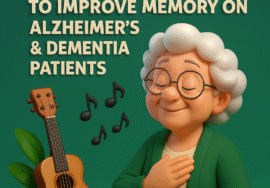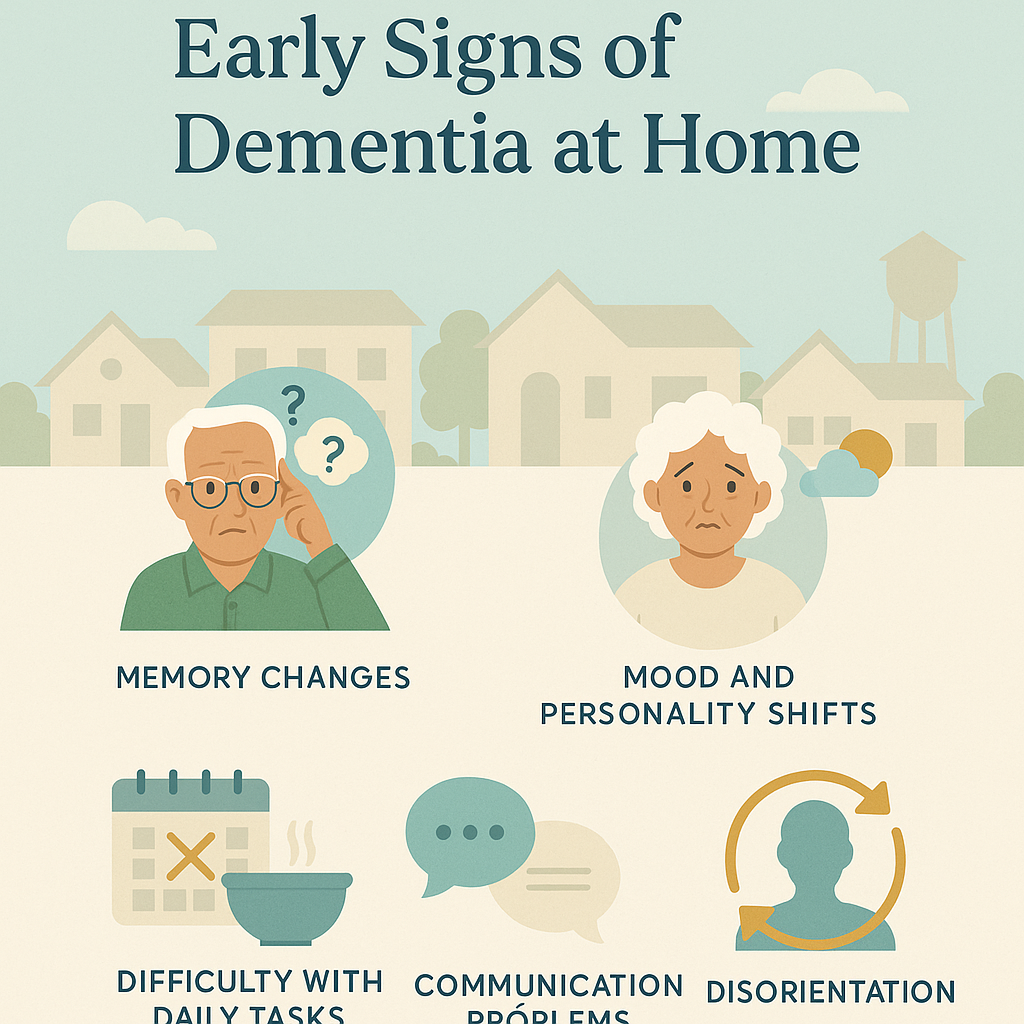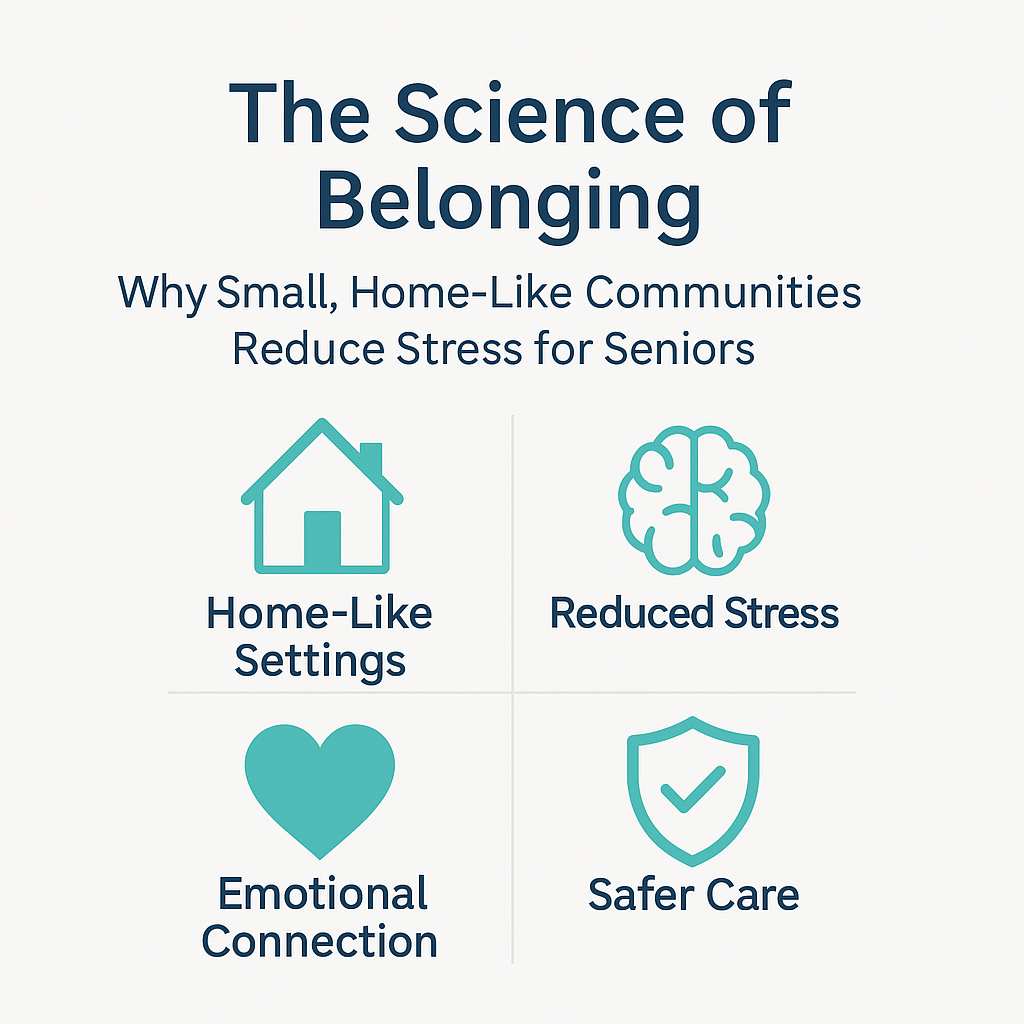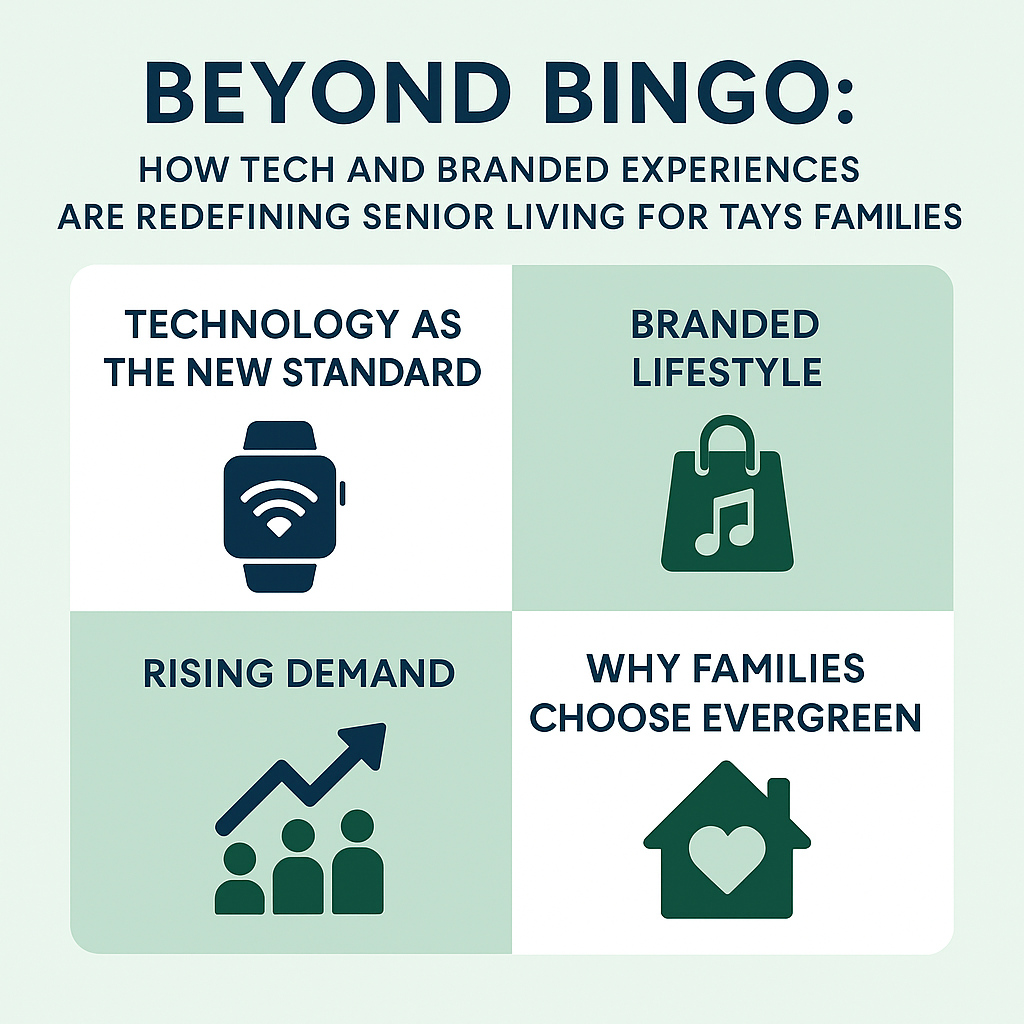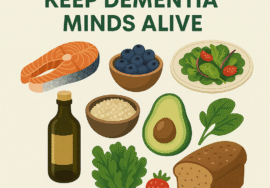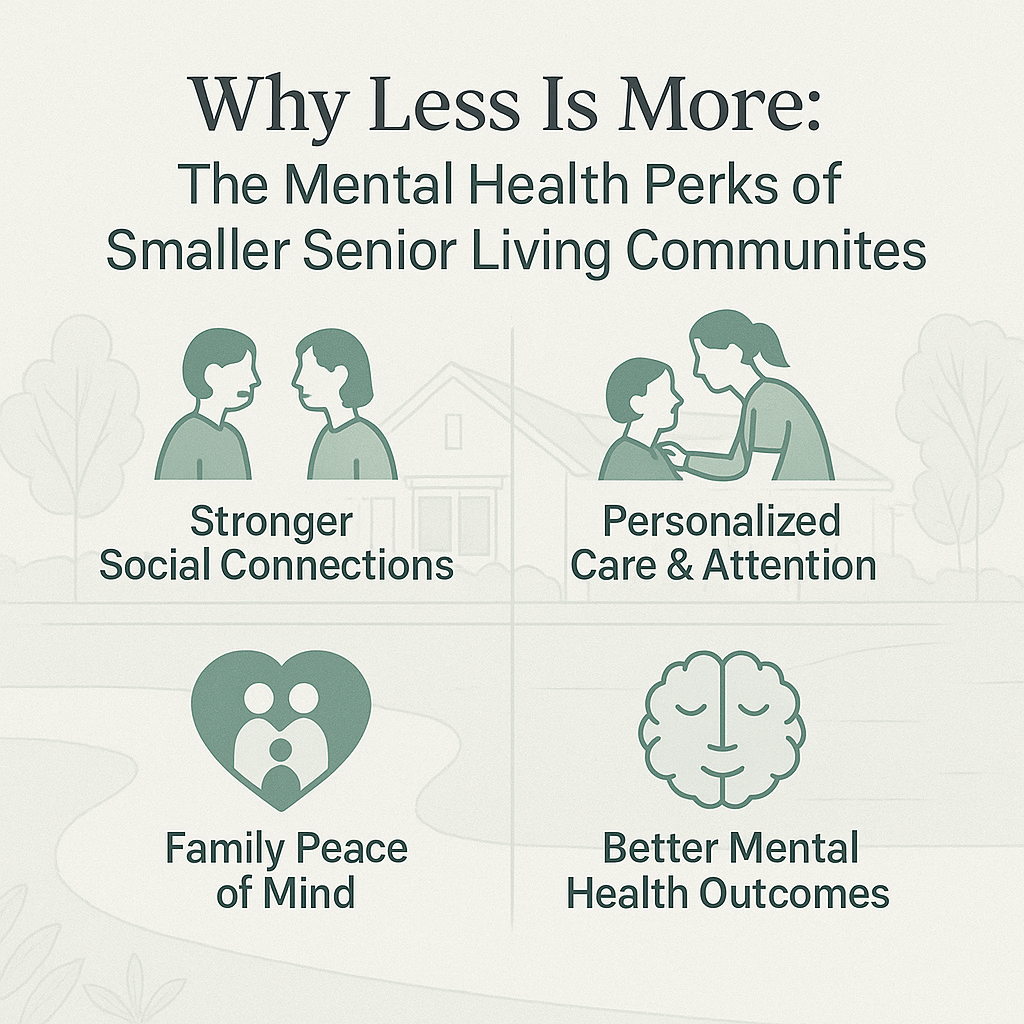
Why Less Is More: The Mental Health Perks of Smaller Senior Living Communities
Table of Contents
- Understanding the Unique Mental Health Needs of Today’s Seniors
- The Science of Belonging: How Smaller Communities Support Emotional Well-Being
- Personalized Care That Builds Confidence and Reduces Anxiety
- Family Peace of Mind: Why Adult Children Prefer Intimate Senior Living Settings
- Choosing the Right Fit in Texas: What to Ask When Touring Smaller Assisted Living Communities
Understanding the Unique Mental Health Needs of Today’s Seniors
Families searching for senior living options in places like Katy, Texas often focus on physical care first: meals, medications, and safety. Yet behind these practical concerns lies an equally important factor—your parent’s mental and emotional health. Research consistently shows that older adults who feel isolated or overlooked are at a higher risk of depression, cognitive decline, and even physical illness. For adult children navigating the difficult decision of placing a loved one in assisted living, understanding these mental health dynamics is essential.
The challenge begins with the natural life changes seniors face. Retirement, loss of lifelong friends, and the passing of a spouse can create profound loneliness. Even when surrounded by people, older adults often describe feeling invisible or disconnected. This sense of emotional isolation is more than a temporary sadness; it can lead to persistent depression and a decline in both cognitive and physical functioning.
In large senior living complexes, the risk of emotional detachment is amplified. Big buildings filled with hundreds of residents may look impressive during a quick tour, but the sheer scale can overwhelm someone who already feels uncertain about leaving their longtime home. Imagine your parent trying to navigate a dining hall that seats 150 people or remembering the names of a new set of neighbors every week. For many seniors, this environment is not just intimidating—it can trigger stress and a sense of being lost in the crowd.
This is where smaller assisted living communities, such as boutique options in and around Katy TX, prove transformative. With fewer residents and a more intimate setting, these communities foster natural friendships and meaningful connections. Staff members know every resident by name and understand their life story, from favorite hobbies to medical needs. This level of familiarity builds trust and encourages seniors to open up emotionally, reducing feelings of loneliness and fear.
Smaller settings also allow caregivers to spot subtle shifts in mood or behavior—signs of depression, early memory changes, or anxiety that might go unnoticed in a larger facility. For families, this means issues are addressed quickly, preventing small concerns from becoming larger health crises. The peace of mind that comes from knowing your loved one’s emotional well-being is carefully monitored cannot be overstated.
For adult children, the journey to finding the right senior living option is often filled with guilt and worry. You may wonder whether you are making the right decision or fear that your parent will feel abandoned. Understanding how the size and culture of a community impact mental health helps replace that anxiety with confidence. When you prioritize emotional well-being alongside physical care, you are not just finding a safe place—you are giving your parent the best chance to thrive.
As we explore the next sections, you will see how science supports the idea that less really is more when it comes to senior living. From the psychology of belonging to the value of personalized care, smaller communities offer more than comfort; they provide the foundation for a vibrant and emotionally healthy life.
The Science of Belonging: How Smaller Communities Support Emotional Well-Being
Belonging is not a luxury in senior living; it is a vital component of health. Psychologists have long established that social connection is as essential to human survival as food and shelter. For older adults, especially those moving into assisted living in places like Katy TX, the need to feel seen and valued becomes even more critical. The transition from a lifelong home to a senior care setting can stir feelings of loss, uncertainty, and vulnerability. In this delicate stage, the environment your loved one enters can either nurture their emotional well-being or compound their stress.
Smaller assisted living communities are uniquely positioned to meet this need for belonging. With fewer residents, relationships form naturally and quickly. Residents recognize one another by name, remember personal details, and develop a true sense of neighborly camaraderie. In these intimate settings, the daily act of sharing meals or participating in activities evolves from routine interaction into genuine friendship. For seniors who have recently lost a spouse or close friends, this immediate sense of inclusion is a lifeline.
By contrast, larger senior living facilities often operate like small towns. While this might appear appealing at first glance, the sheer scale can be overwhelming. A senior stepping into a dining room filled with dozens of unfamiliar faces may feel like a newcomer at a crowded party, unsure where to sit or who to approach. Over time, that discomfort can turn into withdrawal. Instead of socializing, residents may retreat to their rooms, reinforcing loneliness and increasing the risk of depression. Even the most dedicated staff may struggle to recognize subtle emotional shifts in an environment where residents are many and personal interactions are brief.
Intimacy in a smaller community also strengthens the bond between residents and staff. Caregivers become more than service providers; they become trusted companions. They learn not only each resident’s medical needs but also their stories, preferences, and quirks. This deeper relationship means that when a resident seems quieter than usual or shows signs of worry, staff members can respond quickly and compassionately. Families searching for memory care in Katy TX often cite this personal attention as a key reason for choosing a boutique setting over a large complex. It is the difference between your loved one being a name on a chart and being known as an individual whose well-being truly matters.
The psychological benefits of such belonging go beyond day-to-day happiness. Studies show that strong social connections in older adults are associated with slower cognitive decline, lower rates of chronic disease, and longer life expectancy. When seniors engage in meaningful relationships, their brains release oxytocin and other neurochemicals that reduce stress and boost mood. These biological effects translate into better sleep, improved immune function, and a sense of purpose—powerful outcomes for anyone seeking to age with vitality.
For adult children making the difficult decision to transition a parent into assisted living, understanding the science of belonging can ease feelings of guilt and uncertainty. You are not merely choosing a safe place; you are selecting an environment where your loved one can rediscover community and joy. Smaller assisted living communities in Katy TX and throughout Texas give residents more than care—they give them connection, identity, and the comfort of knowing they truly belong.
Personalized Care That Builds Confidence and Reduces Anxiety
When families begin searching for assisted living in Katy TX or surrounding Texas communities, one concern consistently rises to the top: Will my parent receive the attention and care they truly need? This question is more than practical. Beneath it lies an emotional truth—adult children want reassurance that their loved one will not only be safe but will also feel valued, understood, and respected. Smaller senior living communities answer this concern with a level of personalized care that large facilities simply cannot replicate.
Individualized Attention and Consistency
In a small assisted living environment, staff-to-resident ratios are lower, allowing caregivers to spend meaningful time with each resident every day. This consistent interaction fosters trust and reduces the anxiety many seniors feel when transitioning into a new home. Caregivers quickly learn each resident’s routines: when they prefer to wake up, their favorite breakfast, the music that calms them, or the activities that spark their curiosity. This deep familiarity is not merely a nice touch; it is an essential safeguard for mental health. Seniors who feel known and understood experience less stress and are more likely to engage in social activities, which in turn strengthens their emotional resilience.
In large senior living complexes, even the most committed staff members can struggle to provide this level of individualized care. High resident numbers often lead to rotating caregivers, rushed schedules, and an unavoidable sense of impersonality. For seniors already coping with the loss of independence, this can create feelings of invisibility and unease. Anxiety may manifest as sleep disturbances, withdrawal from activities, or even heightened confusion in those with memory challenges. The absence of personal connection can turn what should be a supportive environment into one that feels institutional.
Responsive Care and Early Intervention
Personalized care also allows staff to notice subtle changes in mood or behavior. A small team that knows a resident’s typical demeanor can quickly recognize early signs of depression, loneliness, or the onset of memory-related conditions such as dementia. Families exploring memory care in Katy TX often find this level of attentiveness to be a decisive factor. Early detection and intervention—whether through counseling, adjustments in routine, or medical evaluation—can dramatically improve outcomes and prevent small concerns from becoming serious health issues.
This responsiveness is especially valuable for seniors with chronic conditions or complex medical needs. In a smaller community, the caregiving team has the time and bandwidth to coordinate closely with physicians, track medication responses, and adapt care plans as conditions evolve. The result is not just physical safety but also the emotional reassurance that comes from knowing someone is always paying close attention.
Emotional Security and Confidence
For the adult child making the decision, personalized care provides profound peace of mind. Knowing that your mother or father is not just another resident but a cherished individual reduces the guilt and second-guessing that often accompany the move to assisted living. Your parent, in turn, gains confidence in their new environment. They feel safe to express preferences, participate in activities, and form meaningful relationships, all of which support mental well-being.
Seniors who experience this type of care often rediscover a sense of purpose. Whether it is gardening in a small courtyard, joining a book club, or sharing stories with staff who remember details about their past, these everyday moments of connection cultivate dignity and self-worth. The result is an atmosphere of calm and belonging that nourishes both emotional and cognitive health.
As we continue, the next section will look beyond the residents themselves to explore how these smaller, relationship-driven communities provide something equally important: peace of mind for families. For adult children weighing the emotional and financial realities of assisted living, understanding how intimate communities alleviate worry can make all the difference in choosing the right home.
ChatGPT said:
Family Peace of Mind: Why Adult Children Prefer Intimate Senior Living Settings
For adult children searching for assisted living in Katy TX, the decision to move a parent into a senior community often comes with a heavy mix of love, worry, and guilt. Even when the need is clear—perhaps Mom is forgetting to take her medication or Dad is struggling to maintain the house—families wonder whether a community will truly care for their loved one with the same attention they would provide themselves. Smaller assisted living communities address this emotional burden in ways that go far beyond the logistics of care. They provide families with a sense of reassurance that is both practical and profoundly comforting.
Reassurance Through Visibility and Access
In an intimate senior living environment, family members often notice a culture of openness from the very first visit. Because there are fewer residents and staff, it is easier for families to get to know caregivers personally. This builds trust quickly. Instead of dealing with layers of management or waiting for updates, adult children can communicate directly with the people who interact with their parent every day. When searching for memory care in Katy TX, many families emphasize how much it matters to have a direct line to caregivers who understand their loved one’s unique needs and personality.
This accessibility also means families are more likely to notice the quality of daily life. In a smaller community, you can easily observe how staff and residents engage, how meals are served, and how activities unfold. Seeing these details firsthand reassures adult children that their parent is not only safe but also genuinely cared for. Transparency is not a marketing tactic in these settings; it is a natural byproduct of a close-knit environment.
Consistent Relationships Build Trust
Consistency is another cornerstone of peace of mind. Smaller senior living communities typically experience lower staff turnover because team members form strong relationships with residents and families alike. Adult children quickly learn the names and faces of the caregivers, creating a sense of familiarity that makes every visit more personal. This stability matters deeply when entrusting someone else with the daily well-being of a parent. It allows families to relax, knowing that the people providing care are not just employees but trusted partners in their loved one’s life.
Larger facilities, even with excellent reputations, can struggle to provide this level of consistency. Staff rotations, multiple departments, and higher resident-to-staff ratios can create a more transactional atmosphere. Families may find it harder to connect with a single point of contact or may feel like their concerns get lost in the shuffle. In contrast, smaller communities cultivate a family-like setting where caregivers, residents, and relatives are all part of the same supportive circle.
Emotional Relief for Families
Perhaps the most profound gift of a smaller assisted living community is the emotional relief it offers to adult children. Knowing that your parent is known by name, recognized for their history, and treated with dignity can ease the lingering guilt of moving them out of their home. You can visit without the constant worry of whether they are receiving the attention they deserve. This freedom allows you to return to the role of son or daughter instead of full-time caregiver, restoring the quality of your own relationship with your parent.
Practical Confidence in Long-Term Planning
Smaller communities also simplify the practical aspects of long-term care planning. Whether you are comparing how much assisted living costs in Texas or evaluating memory care options in Katy TX, these intimate settings often provide clear and straightforward communication about pricing, services, and levels of care. Without the bureaucracy of a large corporate structure, families can ask detailed questions and receive transparent answers, making it easier to plan financially and emotionally for the future.
For adult children, this combination of emotional reassurance and practical confidence is invaluable. A smaller assisted living or memory care community becomes more than a place for your parent to live—it becomes a partner in your family’s journey. It allows you to move forward with peace of mind, knowing that your loved one is in an environment where both their mental health and overall well-being are nurtured every day.
Choosing the Right Fit in Texas: What to Ask When Touring Smaller Assisted Living Communities
Finding the ideal assisted living or memory care community in Texas is more than comparing brochures or scanning online reviews. It is an emotional process filled with hopes, questions, and the responsibility of ensuring your parent’s comfort and dignity. Smaller senior living communities can offer the intimate environment and mental health benefits you’ve learned about, but the decision still requires careful evaluation. Touring communities in person—especially those in areas like Katy TX—gives you the insight you need to make a confident choice.
Prepare Your Key Questions Before the Tour
Before visiting, prepare a written list of questions to guide your conversation with staff and management. Focus on both the quality of care and the emotional environment:
- How is care personalized for each resident? Ask how staff members learn about a resident’s routines, preferences, and personal history.
- What is the staff-to-resident ratio, especially during evenings and weekends? A lower ratio typically means more individual attention and faster response times.
- How are changes in a resident’s health or mood handled? Understanding early intervention practices is essential, particularly for families exploring memory care in Katy TX.
- What is included in the monthly fee? Clarify services such as meals, laundry, activities, and personal care to accurately assess how much assisted living costs in Texas.
- How does the community support social engagement? Look for a daily activity schedule that encourages meaningful interaction and connection.
By asking these questions, you ensure that the decision is not only based on appearance or marketing but on the core values that will shape your loved one’s daily life.
Observe Atmosphere and Interaction
While touring, pay attention to the details that reveal the true culture of the community. Notice how staff interact with residents—do they greet them by name, listen patiently, and show genuine warmth? Watch how residents engage with one another. In a small, well-run community, you should see laughter, conversation, and friendships that feel natural, not staged.
Also observe the physical environment: Is it clean, bright, and welcoming? Are there quiet areas for relaxation and cozy spaces that invite conversation? In Katy TX, many smaller assisted living communities highlight home-like features such as private gardens or intimate dining areas that encourage a sense of belonging. These details matter more than grand lobbies or flashy amenities because they directly influence daily happiness and mental well-being.
Consider Location and Family Involvement
Proximity to family is more than a convenience—it is an essential part of sustaining emotional connections. A community near your own home or workplace makes regular visits easier, helping your parent maintain family bonds and giving you reassurance through firsthand observation. Ask how the community involves family members in activities, celebrations, and care planning meetings. Smaller communities often excel in this area, welcoming relatives as active partners rather than occasional visitors.
Weigh the Financial and Long-Term Fit
Cost is always a factor, but it should be considered alongside the quality of care and mental health benefits. Compare how much assisted living costs in Texas across different providers, and ask about potential changes in fees if your parent’s needs increase. Transparent pricing and clear communication about future care options—such as transitions into memory care—will prevent unexpected stress later.
The Value of Trust and Peace of Mind
Ultimately, selecting the right senior living community is about trust. You are choosing partners who will nurture your parent’s mental health, physical well-being, and sense of identity every day. Smaller communities in Katy TX consistently demonstrate that less really can be more: fewer residents mean stronger relationships, closer supervision, and a true sense of belonging that large facilities cannot match.
Frequently Asked Questions
How much does assisted living cost in Texas?
Costs vary depending on the level of care and location, but families typically find that assisted living in Texas ranges from about $3,000 to $5,000 per month. Boutique communities in Katy TX may be on the higher end of this range because of their low staff-to-resident ratios and personalized care, but many families view the mental health and quality-of-life benefits as well worth the investment.
What questions should I ask when touring a senior living community?
Key questions include staff-to-resident ratios, how care is personalized, what is included in the monthly fee, how health changes are managed, and how the community fosters social interaction. Ask about memory care programs if dementia or Alzheimer’s is a concern.
How do smaller assisted living communities benefit mental health?
With fewer residents, these communities create strong social bonds and provide personalized attention. Seniors experience less loneliness, more meaningful relationships, and faster detection of mood or cognitive changes, all of which protect and enhance mental health.
What is the difference between assisted living and memory care in Katy TX?
Assisted living offers support with daily tasks such as meals, medication management, and personal care. Memory care provides specialized programming and secure environments for seniors with Alzheimer’s or other forms of dementia.
How can I ease my parent’s anxiety about moving into assisted living?
Involve your parent in tours and decision-making as much as possible. Highlight the social opportunities, familiar comforts, and personalized care they will receive. Reassure them that you will visit often and remain an active part of their daily life.
Choosing a smaller assisted living community is more than a practical decision; it is an investment in your parent’s emotional and mental well-being. By focusing on connection, personalized care, and the peace of mind that comes from true belonging, you give your loved one not just a safe home, but a happier and healthier future.


